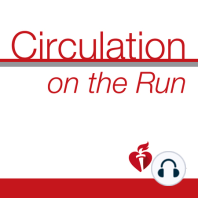16 min listen
Circulation October 2, 2018 Issue
ratings:
Length:
18 minutes
Released:
Oct 1, 2018
Format:
Podcast episode
Description
Dr Carolyn Lam: Welcome to Circulation on the Run, your weekly podcast summary and backstage pass to the journal and its editors. I'm Dr Carolyn Lam, associate editor from the National Heart Center and Duke National University of Singapore. FDG-PET CT was recently introduced as a new tool for the diagnosis of prosthetic valve endocarditis. However, can we improve on its diagnostic performance? Well, to learn more you have to listen to the upcoming featured discussion, right after these summaries. Our first original paper this week describes a potential novel therapy for hypertension. In this study from first author Dr Hu, corresponding author Dr Soong, from Yong Loo Lin School of Medicine National University of Singapore, authors showed that galectin-1 is a key regulator for proteasomal degradation of CaV 1.2 channels. L-type CaV 1.2 channels are known to play crucial roles in the regulation of blood pressure. In a series of elegant in vitro and in vivo experiments, the authors showed that galectin-1 promotes CaV 1.2 degradation by replacing CaV-beta and thereby, exposing specific glycines for polyubiquitination. This mechanistic understanding provided the basis for targeting CaV 1.2 galectin-1 interaction and demonstrated the modulatory role that galectin plays in regulating blood pressure. The study, therefore, offers a potential novel approach for the therapeutic management of hypertension. Direct oral anticoagulants or DOACs, are surpassing warfarin as the anticoagulant of choice for stroke prevention in non-valvular atrial fibrillation. However, DOACs outcomes in elective peri-procedural settings have not been well elucidated and remain a source of concern for clinicians. The next paper in today's issue was a meta-analysis designed to evaluate the peri-procedural safety and ethicacy of DOACs versus warfarin. For author Dr Nazha, corresponding author Dr Spyropoulos, from the Feinstein Institute for Medical Research in Northwell Health at Lenox Hill Hospital in New York, reviewed the literature for data from phase three randomized controlled trials comparing DOACs with warfarin in the peri-procedural period among patients with non-valvular atrial fibrillation. Sub study from four trials were included namely RE-LY, ROCKET-AF, ARISTOTLE, and ENGAGE-AF. The short-term safety and ethicacy of DOACs and warfarin were not different in patients with non-valvular atrial fibrillation peri-procedurally. Under an uninterrupted anticoagulation strategy, DOACs were associated with a 38% lower risk of major bleeds compared to warfarin. The next paper presents results from the Sarcomeric Human Cardiomyopathy Registry or SHARE, which combined longitudinal data sets curated by eight international hypertrophic cardiomyopathy specialty centers to provide a better understanding of the factors that contribute to heterogeneous outcomes in lifetime disease burden in patients with hypertrophic cardiomyopathy. First and corresponding author Dr Ho from Brigham and Women's Hospital and colleagues analyzed longitudinal clinical information on 4,591 patients with hypertrophic cardiomyopathy. By examining the data set spanning more than 24,000 patient-years, the mortality of patients with hypertrophic cardiomyopathy was shown to be 3-fold higher than the general population at similar ages. The lifetime cumulative morbidity of hypertrophic cardiomyopathy was considerable, particularly for patients diagnosed before age 40 years and patients with sarcomere mutations. Atrial fibrillation and heart failure were the dominant components of disease burden. Thus, young age of diagnosis and the presence of sarcomere mutations are powerful predictors of adverse outcomes in hypertrophic cardiomyopathy. These fi
Released:
Oct 1, 2018
Format:
Podcast episode
Titles in the series (100)
Circulation June 6, 2017 Issue: Circulation Weekly: Your Weekly Summary & Backstage Pass To The Journal by Circulation on the Run
